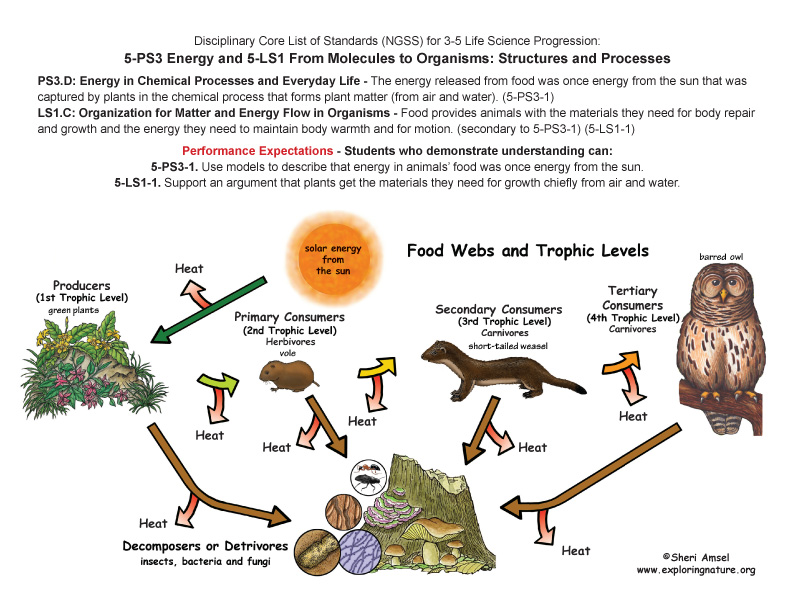

A Disciplinary Core List of Standards (NGSS)
3-5 Life Science Progression:
LS1.A Structure and Function
Organisms have both internal and external macroscopic structures that allow for growth, survival, behavior, and reproduction.
LS1.B Growth and Development of Organisms
Reproduction is essential to every kind of organism. Organisms have unique and diverse life cycles.
LS1.C Organization for Matter and Energy Flow in Organisms
Food provides animals with the materials and energy they need for body repair, growth, warmth, and motion. Plants acquire material for growth chiefly from air, water, and process matter and obtain energy from sunlight, which is used to maintain conditions necessary for survival.
LS1.D Information Processing
Different sense receptors are specialized for particular kinds of information; Animals use their perceptions and memories to guide their actions.
LS2.A Interdependent Relationships in Ecosystems
The food of almost any animal can be traced back to plants. Organisms are related in food webs in which some animals eat plants for food and other animals eat the animals that eat plants, while decomposers restore some materials back to the soil.
LS2.B Cycles of Matter and Energy Transfer in Ecosystems
Matter cycles between the air and soil and among organisms as they live and die.
LS2.C Ecosystem Dynamics, Functioning, and Resilience
When the environment changes some organisms survive and reproduce, some move to new locations, some move into the transformed environment, and some die.
LS2.D Social Interactions and Group Behavior
Being part of a group helps animals obtain food, defend themselves, and cope with changes.
LS3.A Inheritance of Traits
Different organisms vary in how they look and function because they have different inherited information; the environment also affects the traits that an organism develops.
LS3.B Variation of Traits
Different organisms vary in how they look and function because they have different inherited information; the environment also affects the traits that an organism develops.
LS4.A Evidence of Common Ancestry and Diversity
Some living organisms resemble organisms that once lived on Earth. Fossils provide evidence about the types of organisms and environments that existed long ago.
LS4.B Natural Selection
Differences in characteristics between individuals of the same species provide advantages in surviving and reproducing.
LS4.C Adaptation
Particular organisms can only survive in particular environments.
LS4.D Biodiversity and Humans
Populations of organisms live in a variety of habitats. Change in those habitats affects the organisms living there.
_______________________________________________________________________________________________
*ALSO Look for NGSS Performance Expectations included in the PDF below
_______________________________________________________________________________________________
NGSS Illustrated Posters (Below)
Specific Standards Unpacked and Illustrated for Clarity
Print them out for display in classroom.
(Poster PDF is large so will take a few momemts to load.)
When you research information you must cite the reference. Citing for websites is different from citing from books, magazines and periodicals. The style of citing shown here is from the MLA Style Citations (Modern Language Association).
When citing a WEBSITE the general format is as follows.
Author Last Name, First Name(s). "Title: Subtitle of Part of Web Page, if appropriate." Title: Subtitle: Section of Page if appropriate. Sponsoring/Publishing Agency, If Given. Additional significant descriptive information. Date of Electronic Publication or other Date, such as Last Updated. Day Month Year of access < URL >.
Amsel, Sheri. "Grade 3-5 Life Science Standards and Posters (8.5 x11")" Exploring Nature Educational Resource ©2005-2024. December 14, 2024
< http://www.exploringnature.org/db/view/Grade-3-5-Life-Science-Standards-and-Posters-85-x11quot >








